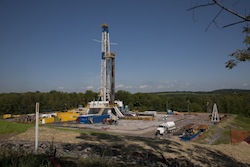Critics of renewable energy have dozens of reasons why alternative energy such as wind and solar just won’t work such as what happens when the wind doesn’t blow and the sun doesn’t shine. But according to a new report prepared by Synapse Energy Economics, “dirty” energy sources including coal-fired electric power, nuclear power and natural gas recovered by fracking, face an even bigger challenge. What are you going to do if the water runs dry?
The report, commissioned by the Civil Society Institute, finds: “Currently, 97 percent of the nation’s electricity comes from thermoelectric or hydroelectric generators, which rely on vast quantities of water to produce electricity … Water is increasingly becoming a limiting factor on U.S. energy production and a key obstacle to maintaining both electricity output and public health and safety. The constraints range from insufficient water supplies to meet power plants’ cooling and pollution control needs—a challenge likely to be exacerbated by  climate change, population growth, and competition from other sectors—to the high costs of energy-related water contamination and thermal pollution.”
climate change, population growth, and competition from other sectors—to the high costs of energy-related water contamination and thermal pollution.”
Synapse Associate Melissa Whited noted, “Our electric system was built on traditional, water-intensive thermoelectric and hydroelectric generators. The water requirements of this energy system are enormous and leave it vulnerable to droughts and heat waves… Going forward, our water resources will be further squeezed by population growth coupled with the impacts of climate change. The massive water use of coal, nuclear, and natural gas generators will be increasingly challenged, particularly when alternatives that require little water, such as wind and solar, are readily available.”
Other key finding of the report include:
- Thermoelectric plants withdraw 41 percent of the nation’s fresh water—more than any other sector.
- The amount of water available to serve diverse needs is a growing concern across the country, from the arid western states to the seemingly water-rich Southeast. Thermoelectric generation compounds the stress already faced by numerous watersheds and adds additional risk for the future. If current trends continue, water supplies will simply be unable to keep up with our growing demands.
- On an average day, water withdrawals across the nation amount to an estimated 85 billion gallons for coal plants, 45 billion gallons for nuclear plants, and 7 billion gallons for natural gas plants. Additional water is required to extract, process, transport, and store fuel, and this water is often degraded in the process.
- Coal mining consumes between 70 million and 260 million gallons of water per day.
- Natural gas fracking requires between two and six million gallons of water per well for injection purposes.
“Continued reliance on water-intensive electric generation technologies puts consumers and regional economies at risk of interruptions in electricity supply or on the hook for costly infrastructure investments,” said CSI Senior Energy Analyst Grant Smith. “To ensure a reliable, cost-effective supply of energy, these water-related risks must be fully accounted for in energy planning and regulation. Once the environmental costs of conventional fuels are recognized, it becomes clear that energy efficiency and renewable energy are bargains by comparison. These clean alternatives cause little if any harmful environmental impacts. On a full-cost accounting basis, clean energy would win out as the least-cost solution and solution that harbors the least risk, as our energy system would no longer threaten (or be vulnerable to) the quantity and quality of our water.”

